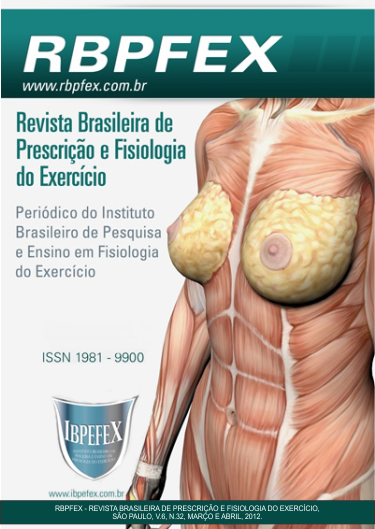Reference values of handgrip mens judo practitioners
Abstract
The goal of this study is to seek reference values of the hand grip strength in male judo athletes, aging 10 to 46 years. JAMAR was the equipment utilized, adjusted for self selection of the subjects, and with one minute interval between the measurements. The positions used for the test followed the ASHT (American Society of Hand Therapists) recommendation, the tested individuals should be seated with their shoulders adducted, their elbows flexed 90◦, and their forearms in neutral. The handgrip strength values were lower in the first group (10-13 years), and rose progressively until de fifth group (26-30 years), when the values start to descend. The table found in our study shows that strength values in different age groups, could provide a reference for athletes and coaches.
References
-Desrosiers, J.; Bravo, G.; Hébert, R. Isometric gripendurance of healthy elderly men and women. Archives of Gerontology and Geriatrics. Vol. 24. 1997. p. 75-85.
-Desrosiers, J.; Hébert, R.; Bravo, G.; Rochette, Annie. Age-related changes in upper extremity performance of elderly people: A longitudinal study. Experimental Gerontology. Vol. 34. 1999. p. 393–405.
-Haidar, S. G.; Kumar, D.; Bassi, R. S.; Deshmukh, S. C. Average versus maximum grip strength: which is more consistent? Journal of Hand Surgery (British and European Volume). Vol. 29B. Num. 1. 2004. p. 82–84.
-Hillman, T.E.; Nunes, Q.M.;Hornby, S.T.; Stanga, Z.; Neal, K.R.; Rowlands, B.J.; Allison, S.P.; Lobo, D.N. A practical posture for hand grip dynamometry in the clinical setting. Clinical Nutrition.Vol. 24. 2005. p. 224–228.
-Ruiz-Ruiz, J.; Mesa, J.L.M.; Gutiérrez, A.; Castilho, M.J. Hand Size Influences Optimal Grip Span in Women but not in Men. The Journal of Hand Surgery. Vol. 27A. 2002. p. 897–901.
-Bohannon, R.W.; Peolsson, A.; Massy-Westropp, N.; Desrosiers, J.; Bear-Lehman, J. Reference values for adult grip strength measured with a Jamar dynamometer: a descriptive meta-analysis. Physiotherapy. Vol. 92. 2006. p. 11-15.
-Godoy, J.R.P.; Barros, J.F.; Moreira, D.; Júnior, W.S. Força de aperto da preensão palmar com o uso do dinamômetro Jamar: revisão de literatura. Revista digital efdeportes.com. Ano 10, Núm. 79. 2004.
-Massy-Westropp, N.; Rankin, W.; Ahen, M.; Krisnhan, J.; Hearn, T. Measuring Grip Strength in Normal Adults: Reference Ranges and a Comparison of Electronic and Hydraulic Instruments. The Journal of Hand Surgery. Vol. 29. Num. 3. 2004.
-Esteves, A.C.; Reis, D.C.; Caldeira, R.M.; Leite, R.M.; Moro, A.R.P.; Borges Junior, N.G. Força de preensão, lateralidade, sexo e características antropométricas da mão de crianças em idade escolar. Revista Brasileira de Cineantropometria & Desempenho Humano. Vol. 7. Num. 2. 2005. p. 69-75.
-Kaya, A.; Ozgocmen, S.; Ardicoglu, O.; Kamanli, A.; Gudul, H. Relationship between Grip Strength and Hand Bone Mineral Density in Healthy Adults. Archives of Medical Research. 36. 2005. p. 603–606.
-Ugrinowitsch, C.; Barbanti, V.J.; Gonçalves, A.; Peres, B.A. Capacidade nos testes isocinéticos em predizer a “performance” no salto vertical em jogadores de voleibol. Revista paulista de educação física. Vol.14. Num.2. julho/dezembro, 2002.
-Amorim, A. R.; Drigo, A.J.; Kokun, E. "Treinamento intermitente no Judô e lactato sanguíneo". In Simpósio Internacional de Ciências do Esporte. Anais, São Paulo, 1994.
-Little, N.G. Physical performance attributes of Junior and Senior women, Juvenile, Junior and Senior men judokas. The Journal of Sports Medicine and Physical Fitness, Vol. 31.1991. p. 510-520.
-Barbosa, A. R.; Souza, J. M. P.; Lebrão, M. L.; Laurenti, R.; Marucci, M. de F. N. Functional limitations of Brazilian elderly by age andgender differences: data from SABE Survey. Caderno de Saúde Pública. Vol. 21. Num. 4. 2005.
-Caporrino, F. A.; Faloppa, F.; Santos, J. B. G. dos; Réssio, C.; Soares, F. H. de C.; Nakachima, L. R.; Segre, N. G. Estudo populacional da força de preensão palmar com dinamômetro JAMAR. Revista Brasileira de Ortopedia. Vol. 33. Num. 2. 1998.
Authors who publish in this journal agree to the following terms:
- Authors retain the copyright and grant the journal the right of first publication, with work simultaneously licensed under the Creative Commons Attribution License BY-NC which allows the sharing of the work with acknowledgment of the authorship of the work and initial publication in this journal.
- Authors are authorized to enter into additional contracts separately for non-exclusive distribution of the version of the work published in this journal (eg, publishing in institutional repository or book chapter), with acknowledgment of authorship and initial publication in this journal.
- Authors are allowed and encouraged to post and distribute their work online (eg, in institutional repositories or on their personal page) at any point before or during the editorial process, as this can bring about productive change as well as increase impact and impact. citation of published work (See The Effect of Free Access).






